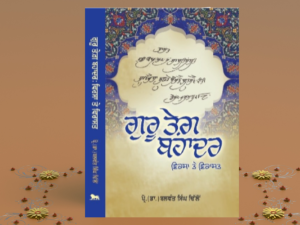Introduction: Documentary series of Guru Nanak's travels by Amardeep Singh of Singapore have established the inclusive nature of Sikh Religion but our Sikh institutions are bent upon making Sikhi exclusive by their narrow-minded approach. Sikhi is at cross-roads and there is a need for a paradigm shift in Sikhi. There is a tug of war between those who want to maintain the status quo and those who want to bring in drastic changes in its structure, theology and institutions. What is a paradigm shift? Google Search led me to various definitions/meanings as follows:
- A fundamental change in approach or underlying assumptions.
- A paradigm shift is defined as "an important change that happens when the usual way of thinking about or doing something is replaced by a new and different way."
- A paradigm shift, a concept identified by the American physicist and philosopher Thomas Kuhn, is a fundamental change in the basic concepts and experimental practices of a scientific discipline. For example, Einstein’s Theory of Relativity brought a paradigm shift in Classical Physics based on Newtonian Concepts of Space and Time.
Out of all these definitions, I will prefer to adopt number 2 for convenience of presenting my views on this topic. Some of the ideas presented in this write up are borrowed from my articles published in The Sikh Review during 2019-20 [1-2]. Based on these ideas, a presentation [3] was made at San Jose in April, 2018, under the rubric, “Why Sikhism Fails to Impact at Global Level?
Need for a Paradigm Shift in Sikhi: The Sikhi of Guru Nanak spread to all those countries which were visited by the Guru during his travels (udasis) of 22 years in all four directions. It was an arduous task to maintain contact with Sikh Sangats by the Gurus who followed in the house of Nanak. As a consequence, these Sangats relapsed back to their original faiths. During the reign of 3rd Guru, Amar Das, efforts were made for preaching Sikhi across the Indian sub-continent by setting up Manjis and Peerhas. Some of the prominent preachers were Sikh women. It is claimed that Bani of Bhagats was collected by Guru Amar Das through these preachers.
The Sikh movement has been undergoing change as a historical necessity from Guru Nanak to Guru Gobind Singh during 238 years of ministry of ten Sikh Gurus. Guru Arjun compiled the Sikh Scripture, Guru Granth Sahib (GGS) and installed it in Harimandir, giving it a sanctimonious status of sabad guru. Construction of Akal Takhat and introduction of Miri-Piri by Guru Hargobind was a paradigm shift in Sikh faith. Introduction of khande-di-pahul for initiation into Sikh faith and creation of Khalsa was the second paradigm shift in Sikhi. The ultimate change was brought by Guru Gobind Singh by declaring GGS as the living eternal Guru of the Sikhs in 1708. Do we need another paradigm shift in Sikhi in this age of Science & Technology?
Some of the mid-course corrections suggested are as follows:
- Make Sikhi Inclusive: The 24 Documentaries of Guru Nanak’s travels prepared and projected by Amardeep Singh of Singapore reveal that remnants of Guru Nanak’s Sikhi still survive in remote corners of India, Pakistan, Afghanistan and Ceylon. There is a need to open channels of communication with Sindhis and other Nanakpanthis to reinvent Sikhi. Give them the freedom to practice Sikhi as they like and provide them all types of logistic support, including supply of copies of Guru Granth Sahib (GGS) and other necessities.
- Voting Rights to Sehajdharis: The original Sikh Rehat Maryada allowed participation of Sehajdhari Sikhs in gurdwara administration. Delhi Sikh Gurdwara Parbandhak Committee (DSGPC) brought a legislation to deprive the Sehajdharis of their voting rights. The same was done by the SGPC through an amendment of the Sikh Gurdwara Act of 1925 which gave them the voting rights. This legislation became a bone of contention and created ill-will between mainstream Sikhi and Sehajdharis.
- Need for Change in Gurdwara Administration: The root cause of trouble in the administration of Gurdwaras all over the world is the process of elections adopted by the Sikhs under duress of the British Indian Government. Election process automatically brings politics in the management of Sikh Gurdwaras. It is the need of the hour to replace election by selection. The Sikh Gurdwara in Bangkok has set an example by following selection of members of committee in the presence of Guru Granth Sahib as ordained in the Sikh history and Sikh ethos.
- Spreading the Universal Message of Shabad Guru: The Sikhs claim that their Scripture has an appeal for the global humanity. Its message of love and peace is Universal. But why do we fail to spread this message at global level? To my mind, we lack resources, not material but academic. We have a lack of competent Sikh scholars who can interpret the message of GGS in the mode and manner suitable for the age of Science and Technology. We need to prepare commentaries on the exegesis of GGS in both Indian and foreign languages.
- Need for Change of Sikhi Narrative: During its naissance and early youth, Sikhi had to wage struggle for its survival. The Sikh psyche could not come out of the narrative of martyrdom suffered by the Sikhs. During our school days, we listened to dhadis (bards) singing glories of Sikh martyrs. Jews have suffered much more in comparison to the Sikhs but their narrative does not glorify their sufferings but their Scholarship. I wish to see a change of narrative in Sikhi, along with the “love for martyrs”, we need to prioritize “love for scholars” in the Sikh fold.
- Need for Change of Infrastructure: The Sikh Gurdwaras were liberated from the clutches of the hereditary mahants by a long drawn struggle waged by the Sikhs during the 1920s. The change took place in the administration but not in the practices being followed by the clergy. The hold of Taksals in training of kathakars and granthis (priests) remained intact. Missionary colleges lacked the infrastructure required to train preachers for the modern age of Science and Technology.
- Sikhi Renaissance: All religions pass through a phase of renaissance. It happened in Christianity during the 14th century with its epicenter in Florence, Italy and spread to the whole of Europe during the 16th to 17th century. It brought revolutionary changes in art, architecture, philosophy, music, literature, science, politics, and religion. The intellectual basis of Renaissance was its version of humanism, “man is the measure of all things”. In India, Raja Ram Mohan Roy is called the father of modern Indian renaissance who was founder of Brahmo Samaj in Bengal. In Sikhi, the Singh Sabha movement started during the 1870s, first in Amritsar and then in Lahore, is considered as the first renaissance which aimed to bring Sikhi back to its pristine glory [4]. Lahore Singh Sabha led by Prof. Gurmukh Singh proved to be more radical and declared unequivocally that “Sikhs are not Hindus”. There is a dire need for a second renaissance in Sikhi. Sikhi Renaissance project has been launched under the aegis of “Global Sikh Council” with Gulbarg Singh Basi (USA) as its Director and Amritpal Singh Sachdeva (UK) as President. I am in touch with both of them for recording my views.
- Need to Remove Illiteracy about Sikh Religion: A survey done by Dr. Rajwant Singh in 2015 regarding the presence of Sikhs in the USA reveals that less than 5 percent Americans are aware of the Sikhs living in the USA as a distinct religious group. The number of Americans who know about GURU NANAK, the founder of Sikh religion is dismally low, less than one percent. In a paper on “Illiteracy about Religions with special reference to Sikhism”, Dr DS Chahal [5] blames Vedanta as the main culprit: “Misrepresentation of Sikhism as a mystical, esoteric, enigmatic, and ritualistic religion is because of illiteracy about Nanakian Philosophy among Sikh and non-Sikh theologians, scholars, researchers and historians. It is due to the fact their main thrust remained to express the philosophy of Guru Nanak under the shadow of Vedanta”. He argues further that the message of Guru Nanak has been misinterpreted: “Guru Nanak has been described only as a mystic man of God with all spiritual powers to perform miracles of various types, but never represented as a philosopher or scientist of the Period of Renaissance, who promulgated universally acceptable philosophy for the humanity of Current Science Age”.
- Need to Participate in Interfaith Dialogues: Guru Nanak is considered to be the pioneer of Interfaith Dialogues during his life-long travels to preach his mission. He proclaimed that the sharing of views and ideas should be a continuous process throughout one’s life:
ਜਬ ਲਗੁ ਦੁਨੀਆ ਰਹੀਐ ਨਾਨਕ ਕਿਛੁ ਸੁਣੀਐ ਕਿਛੁ ਕਹੀਐ ॥
jablagu dunīā rahiye nānak, kichu su_ie kichu kahīe
As long as we are in this world, O Nanak, we should listen, and speak of the Lord.
GGS is well-known in the Scriptures of the World Religions for its cosmopolitan spirit and for being an ideal role model for initiating interfaith dialogue. However, in practice, Sikhs tend to be fastidious about keeping the activities at Gurdwaras to be confined to worship that includes langar and katha-kirtan. We must encourage multi-faith prayers in the Gurdwaras, or allow interfaith events with cultural overtones at Gurdwara premises. To create awareness about Sikhi, participation in Interfaith Dialogues is a must.
- Need to Follow the Middle Path: A new generation of Sikh Scholars wants to bring revolutionary changes in Sikhi. They want to make Sikhi a unique religion which has no links with Hinduism. They forget that the Sikhi is rooted in Hinduism and its scripture draws its imagery largely from Hindu mythology and philosophy. Recently, I listened to some speakers on the “Global Gurmat Vichar Forum, PHX” webinars who proposed to carry out surgical strikes to reform the functioning of Gurdwaras. I believe it will cause more harm than good and cause schisms in Sikhi. A representative body of Sikhi, “Global Sikh Network Organisation” for coordinating activities of Gurdwaras all over the globe, is the need of the hour. The beginning can be made by reinterpretation of GGS using modern techniques of hermeneutics. Dr Gopal Singh refers to this problem in the introduction to his translation of GGS [6]:
"Sikhism is the most modern, yet the most misunderstood of all the religions…..The confusion of interpretation has occurred because the Sikhs themselves for historical and other reasons, have never seriously attempted a scientific and cogent exposition of the doctrine of their faith, based on the word of the Guru-Granth and related to the lives of the Gurus who uttered it…....It has never occurred to the community to define its basic tenets, and to answer the seeming contradictions in these tenets, in short to attempt an integrated account of the Sikh view of life".
References
-
HS Virk. Why Sikhism Fails to Impact at Global Level: Some Random Thoughts. The Sikh Review 67(2), No. 782, 55-66, 2019.
-
HS Virk. How and Why the Message of Guru Nanak got distorted? The Sikh Review, 68(4), 49-56, 2020.
-
HS Virk. Why Sikhism fails to impact at global level? Chardi Kalaa Foundation San Jose Gurdwara, 8 April 2018. Video presentation available at https://www.chardikalaa.com/
-
Wikipedia: https://en.wikipedia.org › wiki › Singh_Sabha_Movem..
-
DS Chahal. Illiteracy about Religions with special reference to Sikhism. Paper presented at International Symposium for Educators, Scholars and policy makers held at Moyse Hall, McGill University, Montreal, Quebec, Canada on October 2, 2009.
-
Gopal Singh. Sri Guru Granth Sahib, Vol. I, 10th edition, World Book Center, New Delhi, 1996, p. xx.






